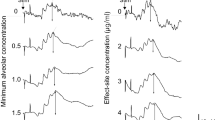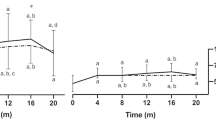Abstract
Fran The effects of sedation and of halogenate anesthesia on electroretinographic recordings were investigated by reviewing the hospital charts of 27 patients who were eventually diagnosed free of retinal disease. The same ERG protocol was performed in conscious (n=9), sedated (chloral hydrate or pentobarbital sodium, n=9) and anesthetized (halothane or isoflurane, in combination with N20, n=9) young patients. Sedation decreased the a- and b-wave amplitude of the scotopic bright-flash response, without affecting implicit times. ERG recordings performed in photopic conditions showed minimal disturbances. Anesthesia spared the a-wave of the scotopic bright-flash response but decreased more severely the b-wave. In addition, anesthesia reduced the amplitude and prolonged the implicit time of the photopic responses, affecting predominantly the ionotropic glutamate dependent OFF components (peak of b-wave, 0P4 and 0P5). The normal retinal physiology is affected by sedation and anesthesia through different mechanisms that still remain to be fully elucidated. These alterations in electroretinographic recordings must be considered when evaluating ERGs obtained under similar sedation/anesthetized conditions.
Similar content being viewed by others
References
Esakowitz L, Kriss A, Shawkat F. A comparison of flash electroretinograms recorded from Burian Allen, JET, C-glide, gold foil, DTL and skin electrodes. Eye 1993; 7 (Pt 1): 169–71.
Gjotterberg M. Electrodes for electroretinography. A comparison of four different types. Arch Ophthalmol 1986; 104(4):569–70.
Vaegan. Electrode standards in electroretinography. Doc Ophthalmol 1996; 92(3): 243–5.
Schmidt B. [Clinical electroretinography in infants without anesthesi] Ber Zusammenkunft Dtsch Ophthalrnol Ges 1969; 69: 558–62.
Eckstein A, Eckstein 5, Ruther K, Zrenner E. [Electroretinography study of unanesthetized young children] KIin Monatsbl Augenheilkd 1994; 204(2): 105–110.
Niemeyer G, GrbovicB, Gloor B. [Diagnosticelec troretinography in the young child] Klin Monatsbl Augenheilkd 1993; 202(5): 417–21.
Marmor MF. Corneal electroretinograms in children without sedation. J Pediatr Ophthalmol 1976; 13(2): 112–6.
Andreasson S, Tornqvist K, Ehinger B. Full-field electroretinograms during general anesthesia in normal children compared to examination with topical anesthesia. Acta Ophthalmol (Copenh) 1993; 71 (4): 491–5.
Brodie S, Breton ME. Modified ERG-jet contact lens electrodes for use in infants and toddlers. DocOphthalmol 1995; 91(2): 141–6.
Lipshitz M, Marino BL, Sanders ST. Chioral hydrate side effects in young children: causes and management. Heart Lung 1993; 22: 408–14.
Slovis TL, Parks C, Reneau D, Becker CJ, Hersch JC, C.D., Ross RD, et al. Pediatricsedation: short-term effects. Pediatr Radiol 1993; 23: 345–8.
Hubbard AM, Markowitz RI, Kimmel B, Kroger M, Bartko MB. Sedation for pediatricpatients undergoing CT and MRI. J Comp Assist Tomogr 1992; 16: 3–6.
Temme JB, Anderson JC, Matecko S. Sedation of children for CT and MRI scanning. Radiology Technology 1990; 61: 283–85.
Cook BA, Bass JW, Nomizu S, Alexander ME. Sedation of children for technical procedures: Current standard of practice. Clin Pediatr (Phila) 1992; 31: 137–42.
Hiatt RL Sr. Examination under anesthesia. Ann Ophthalmol 1990; 22(6): 207–13.
Debrabant F, Hache JC, Cantineau D, Scherpereel P. [Enfluence of low concentrations of halogenated anesthetics on the electroretinogram and visual evoked potentials in chi1dren]. Ann Fr Anesth Reanim 1984; 3(2): 99–104.
Wongpichedchai S, Hansen RM, Koka B, Gudas VM, Fulton AB. Effects of halothane on childrens electroretinograms. Ophthalmology 1992; 99(8): 1309–12.
Raitta C, Karhunen U, Seppalainen AM, Naukkarinen M. Changes in the electroretinogram and visual evoked potentials during general anaesthesia. Albrecht Von Graefes Arch Klim Exp Ophthalmol 1979; 211(2): 139–144.
Tashiro C, Muranishi R, Gomyo I, Mashimo T, Tomi K, Yoshiya I. Electroretinogram as a possible monitor of anes thetic depth. Graefes Arch Clin Exp Ophthalmol 1986; 224(5): 473–6.
Takata I, Adachi E, Chiba J. 4lnfluence of fluothane anesthesia on the human ERGt Nippon Ganka Gakkai Zasshi 1982; 86(12): 2166–71.
Yagi M, Tashiro C, Yoshiya I. [Changes in the electroretinogram during enflurane anesthesia]. Masui 1989; 38(11): 1438–43.
van Norren D, Padmos P. Cone dark adaptation: the influence of halothane anesthesia. Invest Ophthalmol 1975; 14(3): 212–27.
Peachey NS, Alexander KR, Derlacki DJ, Bobak P, Fishman GA. Effects of light adaptation on the response characteristics of human oscillatory potentials. Electroencephalogr Clin Neurophysiol 1991; 78(1): 27–34.
Gouras P, MacKay CJ. Growth in amplitude of the human cone electroretinogram with light adaptation. Invest Ophthalmol Vis Sci 1989; 30(4): 625–30.
Winters WD. Effects of drugs on the electrical activity of the brain: Anesthetics. Annu Rev Pharmacol Toxicol 1976; 16: 413–26.
Thornton C. Evoked potentials in anesthesia. Eur J Anesthesiol 1991; 8: 89–107.
Sloan, TB Evoked Potentials. In: Albin MS, ed. Textbook of neuroanesthesia with neurosurgical and neuroscience perspectives. New York: McGraw-Hill 1997; 211–76.
Sloan TB. Anesthetic effects on electrophysiologic recordings. J. Clin Neurophysiol 1998; 15: 217–26.
Cohen MS, Britt RH, Effects of sodium pentobarbital, ketamine, halothane and chloralose on brainstem auditory evoked responses. Anesth Analg 1982; 61: 338–43.
Smith DI, Kraus N. Effects of chloral hydrate, pentobarbital, ketamine, and curare on the auditory middle frequency response. Am J Otolaryngol 1987; 8: 241–248.
Westall CA, Panton CM, Levin AV. Time cources for maturation of the electroretinogram responses from infancy to adulthood. DocOphthalmol 1999; 96: 355–79.
Wang AD, Costa e Silva I, Symon L, Jewkes D. The effects of halothane on somatosensory and flash visual evoked potentials during operations. Neurol Res 1985; 7: 58–62.
Sebel PS, Ingram DA, Flynn PJ, Rutherfoord CF, Rogers H. Evoked potentials during isoflurane aneshtesia. Br J Anesth 1986; 58: 580–585.
Peterson DO, Drummond JC, Todd MM. Effects of halothane, enflurane, isoflurane and nitrous oxide on somatosensory evoked potentials in humans. Anesthesiology 1986; 65: 35–40.
Bimar-BlancMC, Dejode JM, Bimar J. Effets de lisoflurane et de ihalothane sur les potentiels evoques auditifs et somesthesiques. Ann Fr Anesth Reanim 1988; 7: 279–88.
Wachtmeister L. Further studies of the chemical sensitivity of the oscillatory potentials of the electroretinogram (ERG) I. GABA-and glycine antagonists. Acta Ophthalmol (Copenh) 1980; 58(5): 712–25.
Wachtmeister L. Further studies of the chemical sensitivity of the oscillatory potentials of the electroretinogram (ERG). II. Glutamate-aspartate-and dopamine antagonists. Acta Ophthalmol (Copenh) 1981; 59: 247–258.
Alexander KR, Fishman GA, Peachey NS, Marchese AL, Tso MO. 'On’ response defect in paraneoplastic night blindness with cutaneous malignant melanoma. Invest Ophthalmol Vis Sci 1992; 33: 477–83.
Tremblay F, Lam SR. Distinct electroretinographic oscillatory potentials as revealed by field distribution. DocOphthalmolo 1993; 84: 279–89.
Lam AM, Sharar SR, Mayberg TS, Eng CC. Isoflurane compared with nitrous oxide anaesthesia for intraoperative monitoring of somatosensory-evoked potentials. Can J Anaesth 1994; 41: 295–300.
Schindler E, Muller M, Zickmann B, Osmer C, Wozniak 0, Hempelmann 0. Modulation of somatosensory evoked potentials under various concentrations of desfiurane with and without nitrous oxide. J Neurosurg Anesthesiol 1998; 10: 218–23.
DzoljicM, Erdmann W, DzoljicMR. Visual evoked potentials and nitrous oxide-induced neuronal depression: role for benzodiazepine receptors. Br J Anaesth. 1996; 77: 522–5.
Tanskanen P, Kylma T, Kommonen B, Karhunen U. Propofol influences the electroretinogram to a lesser degree than thiopentone. Acta Anaesthesiol Scand 1996; 40: 480–5.
Savoia G, Esposito C, Belfiore F, Amantea B, Cuocolo R. Propofol infusion and auditory evoked potentials. Anesthesia 1988; 43: 46–9.
Author information
Authors and Affiliations
Rights and permissions
About this article
Cite this article
Tremblay, F., Parkinson, J.E. Alteration of electroretinographic recordings when performed under sedation or halogenate anesthesia in a pediatric population. Doc Ophthalmol 107, 271–279 (2003). https://doi.org/10.1023/B:DOOP.0000005336.08147.fc
Issue Date:
DOI: https://doi.org/10.1023/B:DOOP.0000005336.08147.fc




